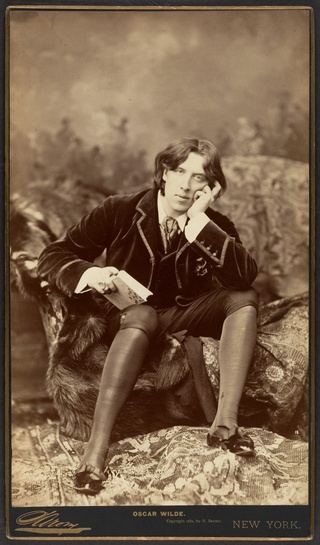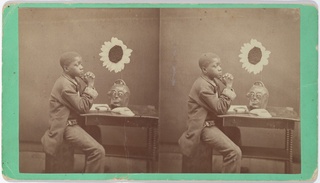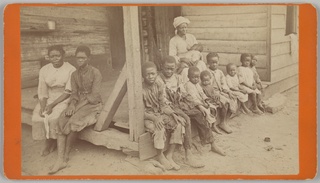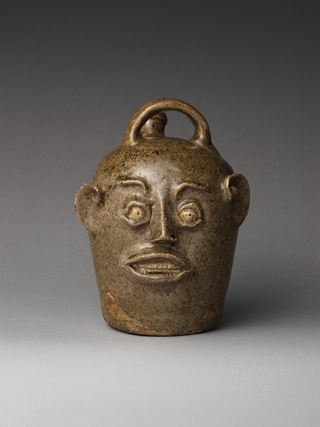The Beauty Remains: Decoding “The Wilde Woman of Aiken”
By Colony Little•May 2022•11 Minute Read
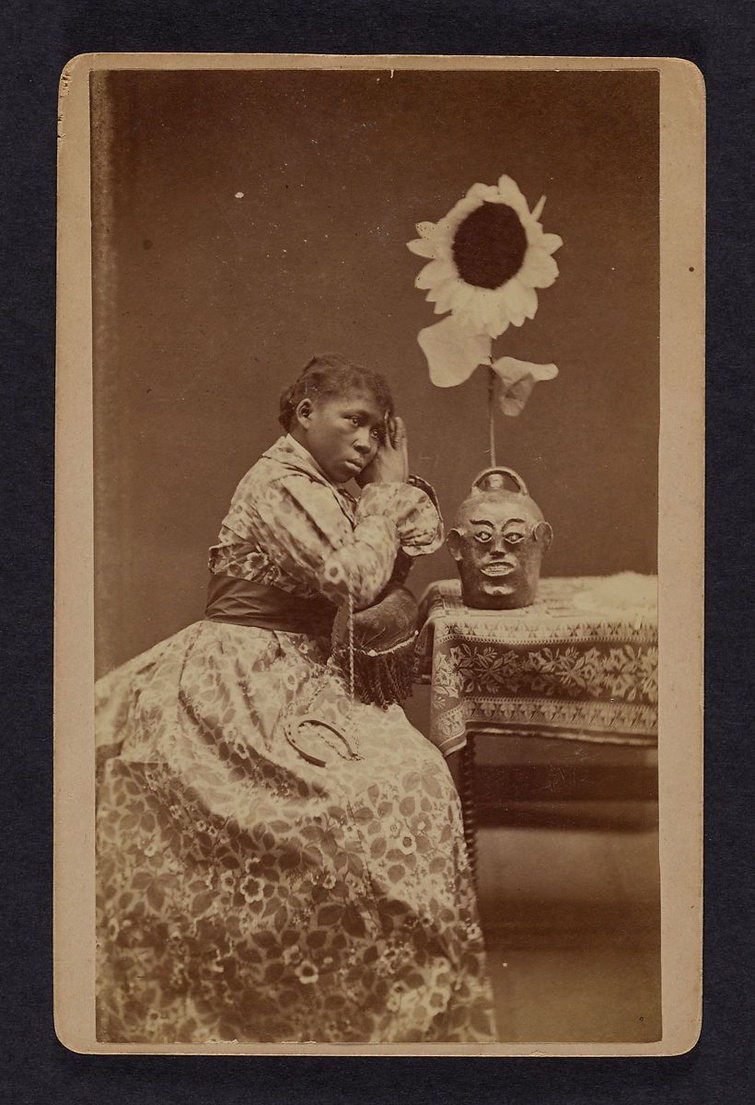
James A. Palmer, The Wilde Woman of Aiken, from the Aiken and Vicinity series, 1882. Metropolitan Museum of Art. A young Black woman sits next to an Edgefield face jug and popular symbols of the Aesthetic Movement.
As photography gained in both popularity and access in the late 19th century, a post-Reconstruction portrait of a young African American woman raises questions about agency, consent, and the definition of beauty.
In 1882, photographer J.A. Palmer composed an image of a young Black woman sitting on a velvet chair in a floral dress. She clasps her hands together against the side of her face, as if in prayer. On a table next to her lies the plumage of a hand fan and an Edgefield face jug containing a large sunflower. At first glance, the genteel details within the vignette appear as post-Civil War signs of progress. They affirm photography’s pivotal role as a tool for documenting status, identity, and—for the formerly enslaved—their humanity. However, in this particular photograph, titled The Wilde Woman of Aiken, other visual clues call the veracity of this reading into question. The jug holding the flower bears a grimacing visage. A curiously placed horseshoe dangles from a gold chain. And then there are her eyes: they are not stoic, but resigned, filled with a palpable sense of sadness that borders on fear.
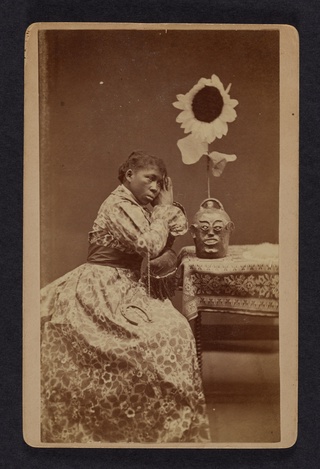
Satirical Origins
The satirical origins of this photograph, which had been relatively unknown until recently, underscore the power of photography to shape perception.1 Unpacking the layered imagery within Palmer’s photograph requires us to consider the three vantage points from which the image is experienced: the photographer, the subject, and the viewer.
In his 1980 book Camera Lucida, Roland Barthes activates these vantage points as intentions: “to do, to undergo, to look.”2 To understand this photograph, we must place each of these three elements in their historical context.
Historical Context
This photo is one of a pair of images by Palmer that satirized the poet Oscar Wilde, who was on tour in 1882 proselytizing on behalf of the English Aesthetic Movement. Aesthetes espoused art and culture by delighting in the sensual pleasures of color and shape. They claimed that beauty is a cultural north star. With his long hair and flamboyant style, Wilde’s sartorial tastes were deemed unconventional by U.S. standards. He became a lightning rod for searing critique by the press during the North American part of his tour. A number of caricatures of the writer circulated like present-day memes. The images and titles of the two photos—The Wilde Woman of Aiken and a stereograph titled An Aesthetic Darkey—are examples of this damning ridicule.3
The photographer James Palmer
James A. Palmer, an Irish photographer, relocated to Aiken, South Carolina after the U.S. Civil War and operated a studio there between 1871 and 1896, where he created stereographs and cabinet cards that documented life in the South. His "Aiken and Vicinity" series featured churches, homes, railroads, and public buildings. He also practiced social documentary, taking numerous photographs of African Americans during Reconstruction. His stereographs depicted what he called “characteristic Southern scenes,” including “Views of Negro Groups, Cabins, Teams, Cotton Fields and Plants.” Very few of his images come with commentary, with the exception of a photograph of a group of children sitting on a porch with a breastfeeding mother. In this instance, Palmer’s notation on the back of the print is telling: “The way the Negro race is dying out.” Whether Palmer’s intentions were altruistic, political, or simply borne out of anthropological interest is unknown, but we can deduce the malevolence behind his imagery by considering his intended audience—the viewer. In order to understand this viewer, we must examine the racist, violent post-Reconstruction South.
Racist Post-Reconstruction South
In the wake of the Civil War, Reconstruction marked a period of social upheaval as newly liberated Black men and women fought for economic and political autonomy through land acquisition, education, and electoral politics. The complex dismantling of Reconstruction in the late 1870s through political policy, lack of judicial intervention, and shifting public opinion reflected the growing resentment of the gains made by African Americans in both the North and South. Palmer opened his studio the same year Aiken County was formed by South Carolina’s majority Black legislature. Shockingly, Palmer’s body of work fails to capture the political strides made by Black lawmakers during Reconstruction. In fact, it appears that his work slowed their momentum by playing a bit part in a campaign to brand Reconstruction as an abject failure.
In South Carolina, newspapers covering Reconstruction began to condemn the state’s Black lawmakers. As Eric Foner notes in his 1990 book, A Short History of Reconstruction, “A spate of articles appeared in middle-class journals like Scribner’s, Harper’s and The Atlantic Monthly, concluding that a return to ‘home rule’ was necessary before good government and regional prosperity returned to the South.”4 In 1874, journalist James S. Pike fomented this rhetoric in his book, The Prostrate State. As media criticism against Reconstruction intensified, Foner writes, “these same journals expressed increasingly retrograde racist attitudes, reflected visually in a shift from engravings depicting the freedmen as upstanding citizens harassed by violent opponents to vicious caricatures presenting them as little more than unbridled animals.”
Pawn in the Satirization of Oscar Wilde
Within this caustic cauldron of political agitation, the subject of Palmer’s photograph became a pawn in the satirization of Oscar Wilde. As Victoria Dailey describes in her extensive account of Wilde’s 1882 tour, these photographs aligned with a series of print caricatures about Wilde that originated with a January 28 Harper’s cover, published shortly after Wilde arrived in the U.S., that featured a monkey in a suit gazing at a sunflower.5 The title of the piece, The Aesthetic Monkey, jabbed directly at Wilde’s fealty to the Aesthetic Movement, whose signifiers were the sunflower, lily, and peacock feather. Palmer situated both of his subjects in compositions with a striking resemblance to the Harper’s cover. In An Aesthetic Darkey, a young man sits at a small bobbin-leg table. On the table is an open book, a calla lily, and the same Edgefield face jug holding a sunflower. These three details mirror elements in the cover. In The Wilde Woman of Aiken, Palmer repurposed the props, adding a floral tapestry and a feathered fan to the table while removing the book. The horseshoe in the young girl’s lap, draped on a chain from her arm, connotes animal husbandry and livestock branding as a sign of ownership—and, in the case of slavery, a barbaric form of punishment.
Edgefield pottery
It is unknown whether or not Palmer was specifically commissioned to create these photographs or if he took the initiative himself. Regardless, one source of his derision has a possible antecedent in Wilde’s criticism of the South vis a vis decorative arts: “The real question that I have found in America standing in the way of its … artistic development,” Wilde said, “is that ordinary handicrafts are not held in their proper honor.”6 Dailey posits that Palmer’s use of the face jug was a swipe at Wilde’s assertion that beauty can be found in crafts, using a rough-looking, oft misunderstood form of pottery created in Edgefield, South Carolina as a seemingly barbarous counterexample.
Of course, this assumption belies the historical origins and spiritual utility of the face jugs created by enslaved potters in Edgefield. These vessels resemble West African Nkisi Nkondi figures.7 They are filled with medicine, soil, or other spiritual materials that are thought to ward off evil spirits. The living often used the jugs to store things like beans or other rations. When the owner died, the jug would be filled with spiritual materials and placed as a grave marker to honor and protect the spirit of the deceased.8 It’s not likely that Palmer would be privy to the spiritual connections of these vessels, which would explain the item’s role as a superficial example of something ugly or unsightly. As Palmer telegraphs his disdain for Wilde, he adds insult to injury by misappropriating Edgefield pottery.

Palmer's Titles
Palmer’s titles, noted on the back of the photos, provide additional context linking the caricatures to Oscar Wilde: “An Aesthetic Darkey” and “The Wilde Woman of Aiken.” These titles reveal motives beyond satire and the vernacular of the time. The moniker of the “Wilde Woman” is an innuendo that harkens back to hypersexual tropes applied to Black women and girls. Indeed, Palmer’s reintroduction of racist, sexist tropes into photographic portraiture constitutes an ironic reversal of how photography was used as an abolitionist tool during slavery.
Photography as an Abolitionist Tool
Frederick Douglass and Sojourner Truth in particular leveraged their own portraits as a visual countermeasure to the racist iconography that bolstered the slave trade. The ubiquity of their daguerreotypes and cartes de visite positively shaped their public images and catalyzed their support within their respective networks. Truth sold her photographs to underwrite her speaking tours. Douglass argued that the medium could be a countervailing force against racist representation and an implement of social change. In her 2012 research, scholar Laura Wexler took this claim further, asserting that Douglass radically expanded the ways critics examine images.9 Foregrounding the three perspectives named by Roland Barthes—photographer, subject, and viewer—Wexler argued that the abolitionist’s wide use and propagation of his photographic portrait in public “excavated a fourth position—that of the revenant or one who returns from the dead.” This fourth position opens the door for us to view The Wilde Woman of Aiken in a new light.
The Revenant
“The Revenant is an effect of ‘liveliness’ produced over time,” Wexler explains in a 2012 lecture. “It requires images that repeat, or return, and to which we also may return multiple times to try to comprehend the intentions of their makers and what has happened to the fulfillment of the aims of the image.”10 Using this broader analysis of a static image frozen in time, we can examine the dynamic cultural conditions that frame the photograph.
The Wilde Woman of Aiken is a hauntingly beautiful image, and the largest contextual chasm is the story of the subject herself. However, one visual clue summons the revenant: despite the fine clothing and decorative accouterments surrounding the young woman, her pained eyes pierce through the photograph. It is this single detail that has remained with me for years.
Conjuring the Wilde Woman
Robin Coste Lewis conjures the voice of The Wilde Woman of Aiken in an eponymous poem written in 2015.11 Through her description of details contained in the photograph, Lewis brings its young, unknown subject power and protection. Calling on Native American agricultural tradition, the sunflower becomes a shield. Through verse, the Wilde Woman seizes narrative control from Palmer, admonishing him with four simple words, while speaking directly to us, the viewers:
You Cannot Prevent me.
Colony Little (she/her/hers) is a Raleigh-based freelance arts writer and the creator of Culture Shock Art, a site dedicated to the synergies among art, music, and design. As a Black woman with familial ties to the South, Little presently writes with a focus on amplifying the artistic voices of Black creators who are influenced by and create work in the American South. Freelance writing credits include ARTnews, ARTS.BLACK, Burnaway, CARLA, INDY Week, Oxford America, Southern Cultures, W Magazine, and Walter Magazine. Little was a 2020 recipient of the Andy Warhol Foundation Arts Writers Grant.
Citations
Dailey, Victoria. “The Wilde Woman and the Sunflower Apostle: Oscar Wilde in the United States.” Los Angeles Review of Books, 8 Feb. 2020, https://lareviewofbooks.org/article/the-wilde-woman-and-the-sunflower-apostle-oscar-wilde-in-the-united-states/#_ftn25. Accessed 10 March 2022.
Barthes, Roland. Camera Lucida. Vintage, 1993.
Palmer, J.A. An Aesthetic Darkey. 1882. The Metropolitan Museum of Art, New York. The Metropolitan Museum of Art, https://www.metmuseum.org/art/collection/search/761731. Accessed 10 March 2022.
Foner, Eric. A Short History of Reconstruction. HarperCollins Publishers, 2015, pp. 222–223.
Dailey, Victoria. “The Wilde Woman and the Sunflower Apostle: Oscar Wilde in the United States.” Los Angeles Review of Books, 8 Feb. 2020, https://lareviewofbooks.org/article/the-wilde-woman-and-the-sunflower-apostle-oscar-wilde-in-the-united-states/#_ftn25. Accessed 10 March 2022.
Lanier, Doris. “Oscar Wilde Tours Georgia: 1882.” The Georgia Historical Quarterly, vol. 65, no. 4, 1981, pp. 329–40, http://www.jstor.org/stable/40580821. Accessed 10 March 2022.
Dr. Shawnya L. Harris and Dr. Peri Klemm, et al. “Power Figure (Nkisi Nkondi), Kongo peoples.” Smarthistory, https://smarthistory.org/nkisi-nkondi-kongo-people/. Accessed 10 March 2022.
“Face Jug.” On History Detectives, Season 8 Episode 8, Public Broadcasting Service, 15 August 2010, https://www.pbs.org/video/history-detectives-face-jug/. Accessed 10 March 2022.
Wexler, Laura. “‘A More Perfect Likeness’: Frederick Douglass and the Image of the Nation,” in Pictures and Progress: Early Photography and the Making of African American Identity, Maurice O. Wallace and Shawn Michelle Smith, Duke University Press, Durham, 2012, pp. 32–33.
Wexler, Laura. “In Order to Form a More Perfect Likeness: Frederick Douglass, Photography and the Image of the Nation.” The Mr. and Mrs. Raymond J. Horowitz Foundation Seminar in New York and American Material Culture, Bard Graduate Center, NY, lecture delivered 28 November 28 2012, https://www.bgc.bard.edu/research-forum/articles/523/in-order-to-form-a. Accessed 10 March 2022.
Lewis, Robin Coste. "Poems from Sanctuary." Transition, vol. 109, 2012, p. 33-42. Project MUSE, muse.jhu.edu/article/490135. Accessed 10 March 2022.
Colony Little (she/her/hers) is a Raleigh-based freelance arts writer and the creator of Culture Shock Art, a site dedicated to the synergies among art, music, and design. As a Black woman with familial ties to the South, Little presently writes with a focus on amplifying the artistic voices of Black creators who are influenced by and create work in the American South. Freelance writing credits include ARTnews, ARTS.BLACK, Burnaway, CARLA, INDY Week, Oxford America, Southern Cultures, W Magazine, and Walter Magazine. Little was a 2020 recipient of the Andy Warhol Foundation Arts Writers Grant.
